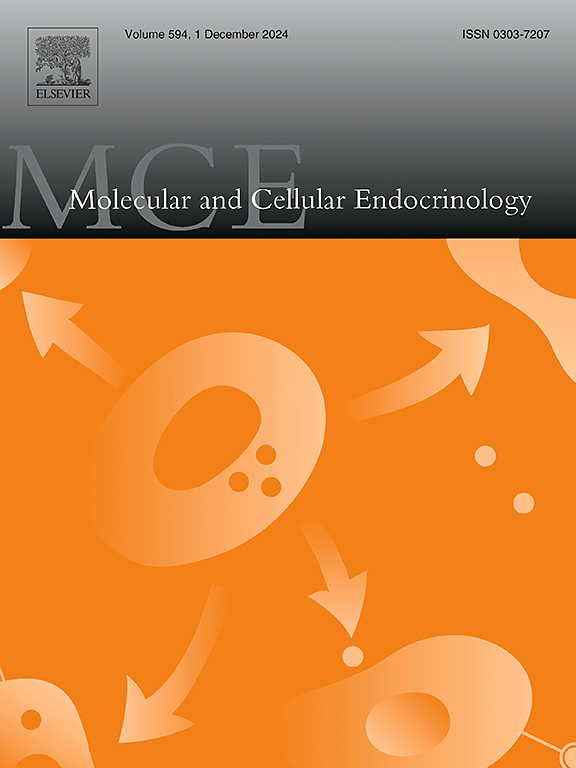雌性大鼠下丘脑发育的转录组学分析。
IF 3.6
3区 医学
Q2 CELL BIOLOGY
引用次数: 0
摘要
下丘脑弓状核(ARC)和腹侧脑室周围核(AVPV)是生殖功能、能量平衡、应激和神经调节的关键调节器。这些区域在神经和胶质细胞群的发育过程中经历了实质性的变化,从而能够获得成人的功能。虽然以前的研究已经检查了特定下丘脑细胞群或基因家族的发育变化,但据我们所知,没有一个研究全面比较了ARC和AVPV在关键发育阶段的无偏倚/大量转录谱。在这项研究中,我们使用3'靶向RNA测序来分析雌性大鼠在婴儿期(P8)、青春期前期(P30)和成年期(P60)的ARC和AVPV中的基因表达。我们进行了无偏和先验选择的差异基因表达分析,后者基因因其在生殖、代谢、应激和神经调节中的作用而被选择。我们还测量了血清激素作为生理指标。发育分析显示,ARC和AVPV在婴儿期和青春期前的基因表达存在显著差异,区域之间存在大量转录重叠。在向成年期过渡期间,观察到的区域特异性转录变化越来越少。基因本体论(GO)分析揭示了青春期前的协调发育程序,包括发育过程的下调和代谢和调节途径的上调。在成年期,AVPV表现出持续的转录重塑,而ARC保持相对稳定。卵泡刺激素是与先天下丘脑基因表达最相关的激素。这些数据为了解雌性大鼠下丘脑发育和激素-基因相互作用提供了参考。本文章由计算机程序翻译,如有差异,请以英文原文为准。
Transcriptomic profiling of hypothalamic development in female rats
The hypothalamic arcuate nucleus (ARC) and anteroventral periventricular nucleus (AVPV) are critical regulators of reproductive function, energy balance, stress, and neuromodulation. These regions undergo substantial changes in neural and glial populations over development that enable the acquisition of adult functions. Although previous studies have examined developmental changes in specific hypothalamic cell populations or gene families, to our knowledge, none has comprehensively compared unbiased/bulk transcriptional profiles across key developmental stages in both the ARC and AVPV. In this study, we used 3′ targeted RNA sequencing to profile gene expression in the ARC and AVPV of female rats at infantile (P8), peripubertal (P30), and adult (P60) life stages. We conducted unbiased and a priori selected differential gene expression analyses, the latter genes selected for their roles in reproduction, metabolism, stress, and neuromodulation. We also measured serum hormones as an index of physiology. Developmental analyses revealed robust differential gene expression between the infantile and prepubertal periods in both the ARC and AVPV, with substantial transcriptional overlap between regions. Fewer and more region-specific transcriptional changes were observed during the transition to adulthood. Gene ontology (GO) analyses revealed coordinated developmental programming prior to puberty, including downregulation of developmental processes and upregulation of metabolic and regulatory pathways. In adulthood, the AVPV showed continued transcriptional remodeling, while the ARC remained comparatively stable. FSH emerged as the strongest hormonal correlate of a priori hypothalamic gene expression. These data provide a reference for understanding hypothalamic development and hormone–gene interactions across life stages in the female rat.
求助全文
通过发布文献求助,成功后即可免费获取论文全文。
去求助
来源期刊

Molecular and Cellular Endocrinology
医学-内分泌学与代谢
CiteScore
9.00
自引率
2.40%
发文量
174
审稿时长
42 days
期刊介绍:
Molecular and Cellular Endocrinology was established in 1974 to meet the demand for integrated publication on all aspects related to the genetic and biochemical effects, synthesis and secretions of extracellular signals (hormones, neurotransmitters, etc.) and to the understanding of cellular regulatory mechanisms involved in hormonal control.
 求助内容:
求助内容: 应助结果提醒方式:
应助结果提醒方式:


